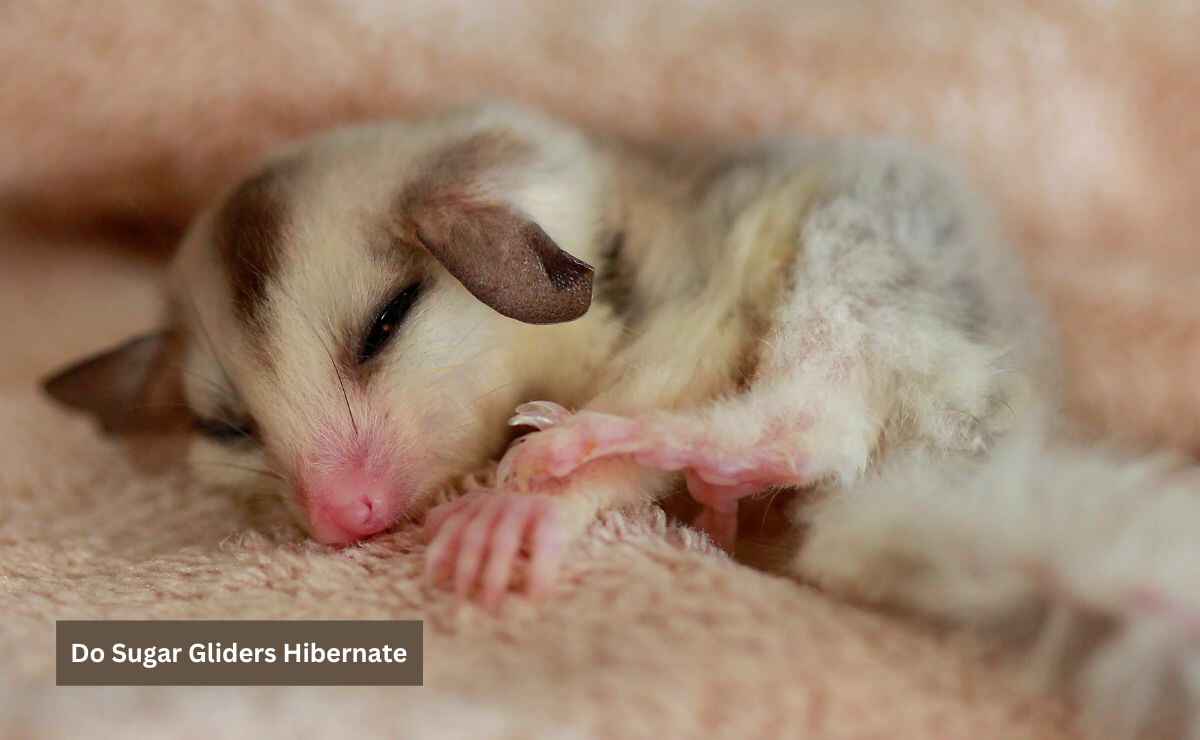Being an owner of sugar gliders is lots of fun. But it’s a responsibility to take care of them. Sometimes it’s a bit confusing at first time. Many pet owners, just like you, have questions about their behavior. One common query is do sugar gliders hibernate?
Well, the answer is no, they don’t actually hibernate. Instead, sugar gliders enter a state of semi-hibernation when it gets cold, called torpor. This helps them conserve energy until the weather warms up again. The interesting part is that once the bad weather passes, sugar gliders can quickly return to their normal activity levels within minutes.
Do Sugar Gliders Hibernate?

Sugar gliders do not hibernate. Hibernation is a state of inactivity characterized by reduced body temperature, heart rate, and metabolism. Sugar gliders are active year-round and do not enter a state of hibernation like some other animals do.
However, sugar gliders are known to exhibit a behavior called torpor during periods of cold temperatures or food scarcity. Torpor is a temporary state of decreased activity and reduced metabolic rate which allows the animal to conserve energy. During torpor, sugar gliders sleep for extended periods, and their body temperature and metabolic rate decrease.
Torpor is not the same as hibernation. Sugar gliders can quickly regain their normal activity levels and metabolic rate once environmental conditions improve. It is a natural adaptation that helps them survive in their native habitats where resources are limited during certain times of the year.
Difference Between Torpor and Hibernation
Torpor is a metabolic state where all energy-consuming processes slow down, and the body temperature drops. It typically lasts for less than 24 hours and includes periods of wakefulness, allowing the animal to forage. Torpor isn’t limited to winter; ill health or other factors can also cause it.
On the other hand, hibernation is a form of controlled hypothermia that enables animals to conserve energy for an extended period. It can last for days to months. It lowers the metabolic rate, decreases body temperature, and slows down breathing.
Unlike torpor, animals in hibernation cannot wake to search for food. Instead, they accumulate energy during warmer months to sustain them through the winter. Importantly, hibernation is specific to winter months.
What Is Torpor?
Torpor is like a strategy when sugar gliders face scarcity of food or feel the threat of increased energy requirements. To maintain body temperature in cold temperatures, sugar gliders usually go through torpor.
Sugar gliders allow their body temperatures to drop significantly and enter a state of complete inactivity to conserve as much energy as possible. But, before they do this, sugar gliders must bulk up on body fat, usually during May in Australia before winter arrives.
It’s interesting to note that many animals that hibernate also experience stages of torpor, where body temperatures drop, and metabolic activity decreases significantly.
Contrary to popular belief, scientists have discovered that sugar gliders in torpor still maintain some control over their core temperatures. They can choose when to raise it if necessary. Hibernation is a challenging state that they entirely switch off their ability to regulate body temperature during this state.
Why Do Sugar Gliders Torpor?
Well, it’s all linked to their native roots in Australia, specifically the southeastern parts. In those regions, temperatures don’t typically drop too low. So, when sugar gliders become pets in other parts of the world, especially where it gets colder, they might struggle a bit.
When the temperature dips below 60 to 70 degrees, sugar gliders start looking for warm spots to curl into a ball to conserve their body heat. Alternatively, they might choose to go through torpor. It’s a state where they conserve energy until the weather improves. However, pet sugar gliders don’t experience torpor as frequently as their wild counterparts.
Those in captivity are less likely to face extremely cold conditions since most indoor spaces are equipped with central heating. Further, there’s usually an ample supply of food, reducing the need for them to resort to torpor. In the wild, sugar gliders may often go through torpor.
How Does Torpor Work?
The process of torpor is very fascinating. You should understand of it so that you can detect their condition and ensure proper care for your little pet.
It all begins a few months before winter, roughly from May to December. In these months, sugar gliders in the Australian wilderness indulge in substantial food intake, gearing up their bodies for the impending scarcity of food in winter.
When the temperatures drop, sugar gliders face the challenge of preserving their body heat. If they maintain their regular activity levels, they risk depleting their energy quickly in the cold, especially with limited food sources, posing a threat to their survival.
To counter this, sugar gliders take control. They deliberately lower their internal temperature significantly and reduce their metabolic activity to channel all available energy towards sustaining them in this dormant state.
Once the harsh weather passes, sugar gliders spring back to life, restoring their original body temperature and activity levels. But it’s a matter of wonder that scientists are still unraveling the mystery of how these small mammals manage to raise their temperature in a matter of minutes.
What Does Torpor Look Like?
It can be a bit alarming for new and inexperienced owners, as a sugar glider in torpor might give the impression of being sick or even lifeless.
Typically, a sugar glider in a torpor will seek out a quiet, dark, and warm space, often huddling away in its nest. During this time, it may show minimal movement and could remain unresponsive when touched or disturbed.
Interestingly, there’s not much one can do to wake a sugar glider from torpor; the best approach is to patiently wait for it to naturally rouse itself. Understanding these behaviors helps alleviate concerns and ensures proper care for your sugar glider during these periods of dormancy.
What Is The Duration Of The Sugar Glider’s Torpor?
Sugar Gliders have the ability to enter torpor whenever they want, but generally, they tend to do so during the day and become active between sunset and sunrise. However, if the nights bring exceptionally cold or rainy weather, they might extend their time in torpor, awakening only when the condition is favorable.
On average, sugar gliders can stay in torpor for a duration ranging from 2 to 23 hours, with the typical duration being around 13 hours. This state allows them to conserve energy effectively. If, for some reason, they’re unable to forage, they will persist in their reduced state of activity until an opportunity to find food presents itself.
The longest recorded time a sugar glider has spent in torpor is approximately 30 hours, showcasing the remarkable adaptability of these creatures to varying conditions.
Conclusion
Sugar gliders use torpor as a clever way to conserve energy, especially in colder weather. This is not hibernation. Torpor lasts for shorter periods, allowing sugar gliders to wake up and find food.
You should understand their natural behavior to provide the best care to your gliders. So, next time you see your sugar glider in torpor, don’t worry – it’s just their way of adapting to the changing seasons and conserving energy.
Also Read
